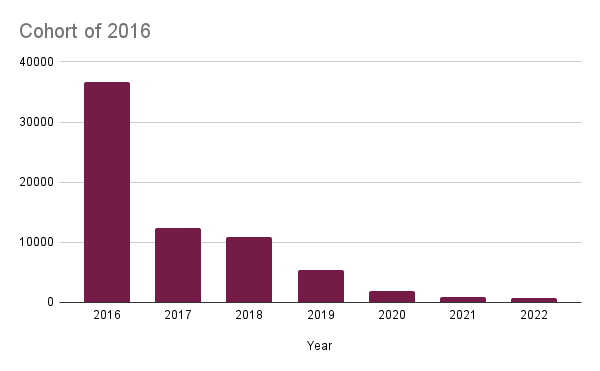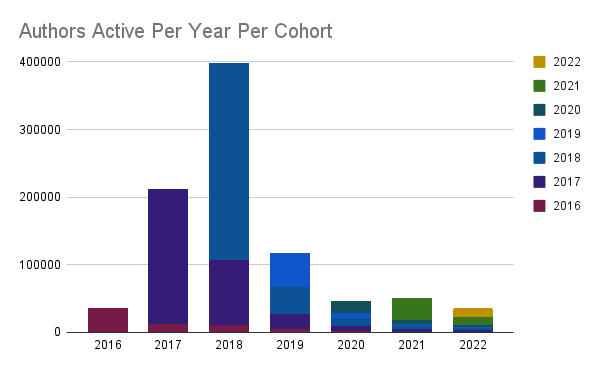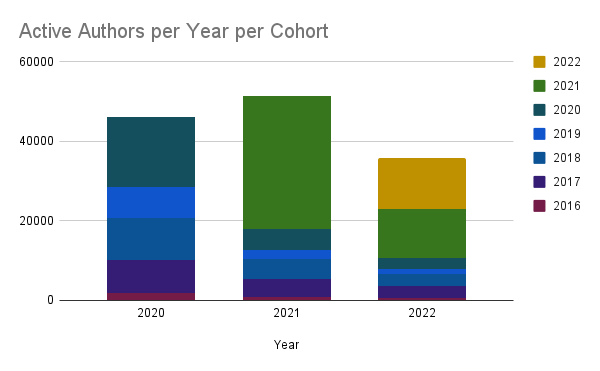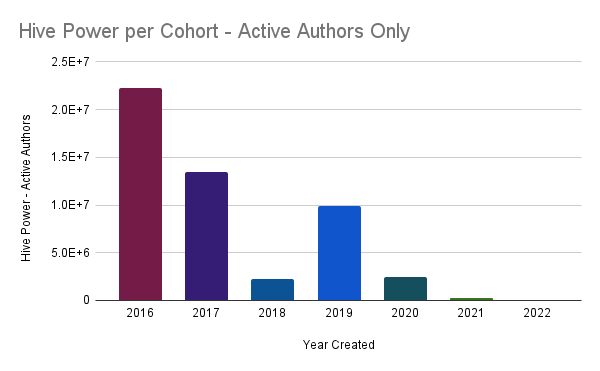User retention and turnover is a much discussed issue on Hive and Steem historically. Retention and turnover are very close conceptually, with turnover being one metric which reflects how well a project is succeeding at user retention. High turnover generally means you are succeeding in bringing in new users, but that those users are not staying for long, which constrains your overall growth. For a project to grow, it must bring in more users every month than it loses. High turnover may be especially bad in a space where there is a significant learning curve, where it not only limits growth but means lost expertise as well.
Cohorts
One way of presenting user retention is to divide our users into cohorts, generally based on when they joined the network. I will define each cohort based on the year of account creation, although I think there is a better way to it this is the simplest and the easiest to grasp at a glance.
The first two charts are the sizes of the cohorts overall, the first based on users who have made a post (aka authors) and the second based on users who have made a vote transaction (aka voters or curators). All further charts will be based on making a post.


The oldest cohort is the original from 2016. Not the largest, but with the longest history, it shows the typical journey of a cohort - they typically get smaller every year as fewer users continue to post. A mere 670 accounts from the 2016 cohort have made a post this year.

Big Picture
Since there have been 7 calendar years since the start of Steem/Hive, there are 7 cohorts overall. Their activity can be seen in the stacked bar chart below.

As is clear above, the largest cohorts of 2017 and 2018 dominate the chart, despite being mostly gone by 2020, the year of the Hive exodus fork. The cohorts of the Steem era were vastly larger than after the fork. That is despite the success Hive has had in the last year. Of course, it could look very different if custom_json transactions were the basis of this post.
For the sake of readability, here is the chart again starting in 2020 (the year of the Hive exodus fork).

Some notes again: We're only half way through 2022, the chart will look different when the year ends.
Although the decline in active authors has slowed, lack of user retention and high turnover absolutely still seem to be a problem in Hive.
Stakeholding by Cohort
Before I finish, I think it's also worth briefly looking at the holdings of stake between the different Hive cohorts. The first is based on the entirety of the cohorts regardless of posting or voting activity.

When we only include those who made a post this year things shift somewhat, with the 2019 cohort gaining significantly in relevance. I don't know why the 2018 cohort diminishes so much here. 2022 cohort is barely visible.

However when active voters are considered instead, the 2017 cohort gains, although still is behind the really old guard.

Although a tiny fraction of the original cohorts have remained, those who did have a massive disproportionate stake in the network overall.
It seems like almost a congestion effect right there. The huge crowd squeezes into the little world with limited resources (e.g., whales), and only a few can get decent rewards. The more content the system is filled with, the less the average reward for each creator, unless there are many whale-like investors.
Also, the learning curve is quite large for first-time users. With all the voting, reward, reputation, punishment, and delegation systems, I just feel like the system is made too complicated for just a blogging platform. Even if someone wants to investigate the root problems (e.g., coalition), it is quite difficult to figure out where to start with. I am currently decomposing those systems and trying to investigate the economic dynamic little by little.
Moreover, if people join and expect the creator to be a full-time job, it simply won't work. It will end up with complaints of unfairness, etc. Because they rely too much on the token economy and care too much about loss and win. There is no enjoyment, no intrinsic values, no fun. Pretty much like nowadays' gig economy.
I don't think this is the case. Hivers leave in the same proportion basically every month since the fork. The rewards per post adjust substantially, and if anything are actually higher when the larger numbers of people left historically.
https://peakd.com/hive-133987/@demotruk/do-hivers-leave-because-of-lack-of-rewards
We have had issues retaining users. I think that when the price drops then a lot of people who were not making much anyway give up, whereas those who have been around longer know things can pick up. All that $HIVE I earned at 10c is worth way more now.
Obviously we lost a lot after the split from 'the other chain'. I don't know how many went to Blurt, but it doesn't look too active over there.
I do think we need to work on retention as well as recruitment. It takes time to get established and we have to steer people away from bad behaviours without totally scaring them away. It's up to the community to do these things as we don't have big marketing and user relations teams.
Well done on putting all this together.
I would like to seem comment data.
Some users comment but don't create new posts.
Not sure if this will change things tho
If people are active then that is good. Not everyone wants to write posts, but they can still earn anyway.
The author data includes users who only comment.
Yes and onboarding them
https://peakd.com/thehive/@antisocialist/the-daily-meme-372
It makes perfect sense as the early adopters have enough stake to make it worthwhile but they mostly vote among themselves and newbs burn out before very long.
This is an excellent point.
If Hive is successful in the long run, we should be seeing gradual increase over time.
It's better now than ever, imo.
Very interesting analysis, thank you. I think the problem is that many leave Hive again if their first few posts don't get any attention (votes, comments). We probably need to work on that.
And not just/only on their first few posts. Everyone need regular support. People should support each other. There should be a teamwork. But many people focus on the individual growth, instead of the collective growth.
I have noticed people leave even faster if their first post gets a huge reward. Only because it is unsustainable.
What do you mean? Shouldn't they be more motivated to stay if they see that they can earn something?
It would be logical to think so, but it seems logic doesn't help when people act through their feelings.
Thank you for your witness vote!
Have a !BEER on me!
To Opt-Out of my witness beer program just comment STOP below
Thanks! =)
View or trade
BEER.Hey @grider123, here is a little bit of
BEERfrom @isnochys for you. Enjoy it!Did you know that you can use BEER at dCity game to **buy dCity NFT cards** to rule the world.
This is a nice breakdown of long-term development. It's interesting to see that the share of the 2016 users is small in activity but huge in HP.
I would also be interested to see how the data changes over time in relation to the price history. I for one, tend to be more motivated to participate on the platform when prices are up.
Very interesting to see these stats. I'm part of the "2018 Cohort" and still going strong; no intention of stopping anytime soon.
Whereas I probably posted the most in my first year, trying to build the account, I think my annual output has been pretty consistent since then. I wonder if there's a "tipping point" at which people become "long timers," regardless of what the token price does?
Cool post; thanks for putting this together!
=^..^=
Very interesting data. What was happening in 2018 that caused turn-over to skyrocket? Was there a surge in education that helped users to get through the set up phase and make their first post?
To be honest, I do not know. Steemit Inc fixed their onboarding problems in mid 2018, but a lot of that year had massive user registration issues.
there was a waiting period in 2018 for accounts but a lot of accounts were created then. If i remember the data end of 2017 and first half of 2018 had the most account created on the chain (maybe till the boom of splinterlands).
A lot of accounts were bots as there was good amount of people trying to exploit the bull market of steem those days.
I do feel that there is a good amount of 2018 accounts still active, or maybe it is just that i most people i know here are from those times.
Seems plausible, the numbers would be inflated by users coming in through those YT promoters. And then after the bid bots were killed off in HF21 the profit seekers would flock elsewhere.
A Problem that'll need to be resolved sooner or later
You are absolutely right. I registered on 2017.05.17, and I saw thousands of people leaving the platform over the years. Nowadays most of my followers are inactive. Most of them left the platform years ago. I also left the platform a few times, but I always returned.
I for one am glad you did. I miss many of those who have left.
Very good to hear this. Thank you. Literally hundreds of thousands of people left over the years.
Very interesting data, I find that despite the lack of users lately Hive keeps its price pretty well
This is good information.
I think projects like Splinterlands, Leofinance are bringing in new users to hive. We need more such projects. There might be many who just interact with the hive blockchain via Splinterlands alone. Are they treated as active ?
No, each of the charts is based on either posting or voting.
I'll make another post to include custom_json transactions which will include most dapp users.
Those stats would be interesting to know. Following you so that I don't miss the next post.
~~~ embed:1541861034264145920 twitter metadata:SGl2ZVRyZW5kaW5nfHxodHRwczovL3R3aXR0ZXIuY29tL0hpdmVUcmVuZGluZy9zdGF0dXMvMTU0MTg2MTAzNDI2NDE0NTkyMHw= ~~~
The rewards earned on this comment will go directly to the people( @enjar ) sharing the post on Twitter as long as they are registered with @poshtoken. Sign up at https://hiveposh.com.
Thanks for feeding us with the information.
I started this year with the purpose of complete transitioning from web2 like many more I am sure. So the years ahead may bring better retention, and more if the improvements are attractive to stay.
I'm technically one of the 2017 cohorts, but my account was created in December and so I feel like I'm more of a 2018 cohort as a result.
That said, a lot of the people I met around that time have left. Damn shame, really...
It'll go down even further when onboarding is not handled with. I never understood how @manncpt could take so long until I was in the same predicament https://hive.blog/hive-193552/@mochita/actifit-mochita-20220612t195120096z
I'm very hopeful and optimistic @theycallmedan 's curation program will have a more positive impact
In January we had a bit problems with onboarding a new user because hiveonboard.com didn't work anymore. It was a very fast solution we always used until then...
Yes absolutely. Luckily the actifit team helped me out with a promo code. I apologize for not showing more empathy back then